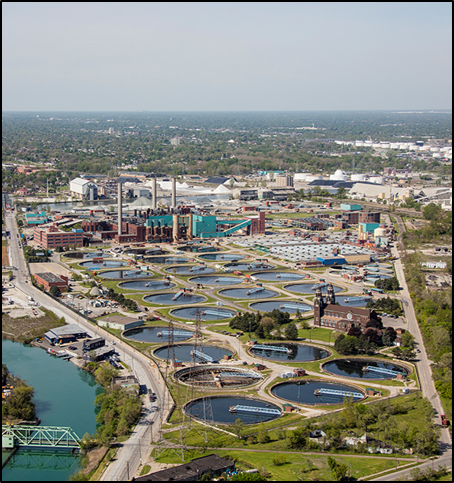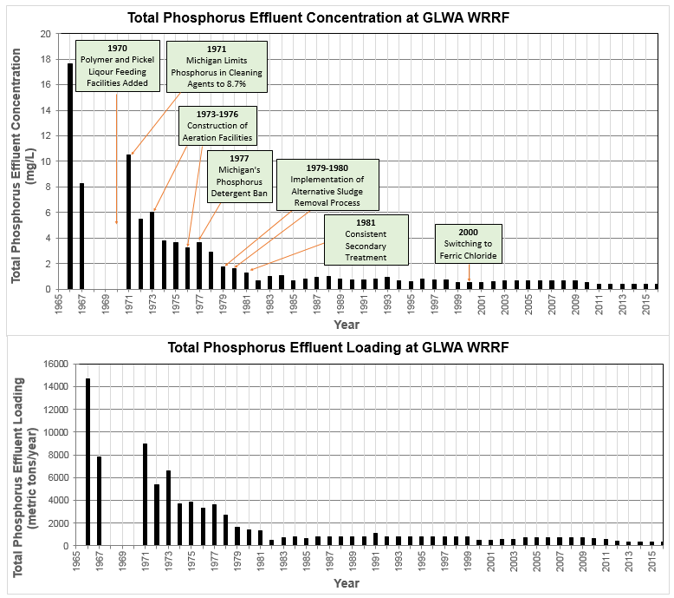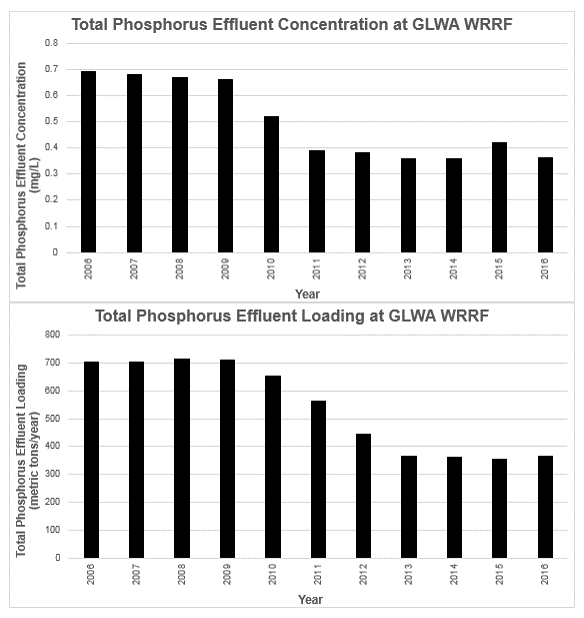Detroit River-Western Lake Erie Basin Indicator Project
Phosphorus Discharges from Great Lakes Water Authority’s Water Resource Recovery Facility
Authors
Majid Khan, PhD, Wastewater Operations, Majid.Khan@glwater.orgEd Hogan, PE, Wade Trim, ehogan@wadetrim.com
Imad Salim, PhD, PE, Wade Trim, isalim@wadetrim.com
Background
Lake Erie has a long history of accelerated eutrophication. During the 1960s, Lake Erie was on the front cover of several national magazines because phosphorus-induced algal blooms and oxygen depletion of deeper waters caused fish kills. In general, phosphorus is the most scarce and readily controllable nutrient relative to plant needs. Therefore, the United States and Canadian governments worked through the Great Lakes Water Quality Agreement to set phosphorus target loads to control water quality problems associated with phosphorus enrichment. This phosphorus control program called for controlling inputs from municipal wastewater treatment plants, controlling inputs from agricultural and urban runoff, and restricting the phosphorus content of cleaning agents and laundry detergents. The Great Lakes Water Authority’s (GLWA) Water Resource Recovery Facility (WRRF), formerly known as the Detroit Wastewater Treatment Plant, was the single largest point-source contributor of phosphorus to Lake Erie. This regional wastewater treatment plant was constructed in 1940, subsequently expanded to accommodate growth, and currently serves over three million people in 78 communities. This facility provides both primary and secondary treatment to 2,461 million liters (650 million gallons per day (MGD)) of wastewater on an average day, but has the sustained peak capacity of 1700 MGD of primary treatment, and 930 MGD of secondary treatment.(Figure 1).

Figure 1. An aerial photograph of GLWA’s Water Resource Recovery Facility - one of the largest in North America
Status and Trends
In 1970, the Detroit Wastewater Treatment Plant began removing phosphorus from its effluent using pickle liquor (ferrous chloride) and polymer to meet the 1 mg/L phosphorus effluent standard for all major plants (3.8 million liters; one million gallons per day or greater). Pickle liquor was obtained from local steel mills and pumped or fed by gravity into plant headworks, while polymer was injected into channels leading to the primary clarifiers. Aeration facilities for secondary biological treatment were constructed during 1973-1976. Through this process, ferrous chloride is converted to ferric chloride, which has been found to more effectively precipitate phosphorus. During 1979-1980, staff at the plant implemented an alternative sludge removal process which increased sludge handling capability and indirectly increased the plant’s ability to remove phosphorus.
Two statewide phosphorus control initiatives were also implemented. In 1971, Michigan enacted a phosphorus limitation of 8.7 percent by weight on all cleaning agents. Michigan’s phosphorus detergent ban was implemented in 1977, restricting the phosphorus content of household laundry detergents to no greater than 0.5 percent by weight.
The combined influence of these phosphorus control efforts can be seen in Figure 2a and 2b below. The result was a greater than 90 percent reduction in phosphorus concentration and loading from the Detroit Wastewater Treatment Plant. Similar reductions occurred in other wastewater treatment plants; however, because of the Detroit plant’s 2,461 million liters (650 million gallons) per day flow, the impact on Lake Erie was substantial. Phosphorous reductions at the Detroit Wastewater Treatment Plant would become the single largest cause of the reversal of cultural eutrophication of Lake Erie during the 1970s and 1980s. Lake Erie responded with dramatic improvements in water quality.
With the passing of the Clean Water Act in 1972, and the issuance of the first National Pollutant Discharge Elimination System (NPDES) permit, there were a number of problems with consistent and adequate operation of the plant. These problems climaxed in a 1977 Federal Consent Judgment, which outlined the specific deficiencies, areas requiring improvement, and target dates for achieving compliance. A full-scale evaluation of the plant was performed in 1979 to identify the treatment capacity and capability, additional capital improvements, and to help ensure adequate operation of the plant. It was not until 1981, when the construction and modification of secondary settling tanks were completed, that the plant would achieve consistent operation sufficient for secondary treatment standards.

Figure 2a and 2b. Total phosphorus effluent concentration (a) and effluent loading (b) from Great Lakes Water Recovery Facility, 1966-2016.
The story of reductions in phosphorus loadings and the subsequent reversal of cultural eutrophication of Lake Erie is one of the greatest success stories of water resource management. Indeed, the US-Canada phosphorus control program is heralded as an international model.
By the early 1990s, zebra and quagga mussels invaded Lake Erie causing major changes in the food web and lake ecosystem. Additionally, farming practices changed over a similar time frame, with the advent of no-till farming and increased use of drain tiles. In recent years, blooms of blue-green algae have occurred in the Western Lake Erie Basin, particularly in the mouth of the Maumee River, raising new concerns. The exact reasons for these blooms are uncertain. Did increased discharge of nutrients occur? Did zebra mussels change the water quality and favor productivity of blue-green algae? Will this lead to more taste and odor problems in drinking water supplies? Research needs to be focused on answering such questions.
In the meantime, Michigan implemented a statewide residential fertilizer phosphorous ban in 2012. Concurrently, GLWA has moved forward with a set of treatment process measures to further mitigate phosphorus impact on the Detroit River. These measures include refinements in the Ferric Chloride dosing and secondary treatment processes including:
- Maintaining a minimum of 0.5 mg/l phosphorus in the influent to secondary treatment to maintain a healthy level of nutrients for the secondary biological process that results in a better overall phosphorus removal;
- Maintaining solids inventory below 500 dry tons;
- Maintaining solids retention time close to 24 hours; and,
- Keeping dissolved oxygen levels between 2.0 and 4.0 ppm in the last-bay of aeration basins.
Reflecting the success of the WRRF in reducing phosphorus discharge limits, the NPDES permit issued March 2013 was modified to reduce the phosphorus discharge limits from 1.0 mg/l to 0.7 mg/l effective in 2015. In 2016, the permit further reduced the phosphorus discharge limits to 0.6 mg/l during the Growing Season.

Figure 3a and 3b. Total phosphorus effluent concentration (a) and effluent loading (b) from Great Lakes Water Recovery Facility, 2006-2016.
Management Next Steps
In June 2015, the states of Michigan and Ohio, together with the Province of Ontario entered into the Western Basin of Lake Erie Collaborative Agreement (Agreement). This Agreement established a collaborative initiative with a defined goal of achieving a 40 percent load reduction in total and dissolved phosphorus entering the Western Basin by year 2025, and an interim goal of a 20 percent reduction by 2020. Each state and province has committed to developing, with stakeholder involvement, a plan identifying their proposed actions and timelines toward achieving this phosphorus reduction goal, including measuring progress through established and defined benchmarks and reporting.
Current management efforts are focused on farming practices along major tributaries to western Lake Erie, as well as maintaining the significant phosphorous reductions from the GLWA WRRF. The major changes that have occurred in Lake Erie in recent years are not well understood. However, it is clear that management programs, research and monitoring must be sustained and closely coupled in order to achieve management goals for the Detroit River and Lake Erie. The Lake Erie Committee of the Great Lakes Fishery Commission has recommended a “hold-the-line on phosphorus levels” until there is clear scientific evidence that suggests otherwise.
Research/Monitoring Needs
Phosphorous reduction goals identified in the Western Lake Erie Basin Collaborative are specifically designed to reduce nuisance algae blooms. This is different than the harmful algal blooms which are associated with the presence of algal toxins at unacceptable levels. It is hoped that by reducing the nuisance algae blooms, that a reduction in harmful algal blooms will also occur.
Under a 2012 amendment to the Great Lakes Water Quality Agreement, a multi-modeling program was developed and implemented. A final report was completed on August 31, 2016 under the Nutrient Annex 4 Objectives and Targets Development Task Force. Significantly, the report concludes that achieving cyanobacteria biomass reduction in the Wester Basin requires a focus on reducing total phosphorous loading from the Maumee River, with emphasis on high-flow event loads in the period from March through July. The results further state that the phosphorous load from the Detroit River is not a driver of cyanobacteria blooms.
Monitoring and research must be sustained for calculating reliable loading estimates, evaluating impacts of remedial efforts, understanding short- and long-term ecosystem trends, and refining modeling frameworks applied for management and decision making. Coordinated, comprehensive research will be needed to understand cause-and-effect relationships relative to the recent changes in Lake Erie and to ensure ecosystem-based management.
References
- Panek, J., D.M. Dolan, and J.H. Hartig. 2003. Detroit’s role in reversing cultural eutrophication of Lake Erie. In Honoring Our Detroit River: Caring for Our Home, ed. John H. Hartig, pp. 79-90. Bloomfield Hills, MI: Cranbrook Institute of Science.
- Michigan Implementation Plan, Western Lake Erie Basin Collaborative, 2016, MDEQ.
Contact Information regarding Phosphorus Discharges from Great Lakes Water Authority’s Water Resource Recovery Facility
Majid Khan, PhD
Director, Wastewater OperationsE-Mail Address: Majid.Khan@glwater.org
Ed Hogan, PE
Senior Project Manager, Wade TrimE-Mail Address: ehogan@wadetrim.com
Imad Salim, PhD, PE
Technical Lead for Wet Weather Planning, Wade TrimE-Mail Address: isalim@wadetrim.com